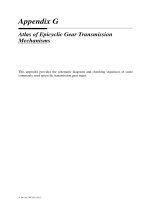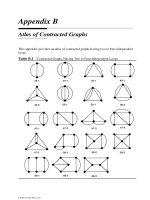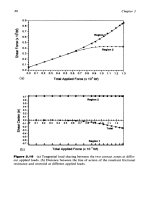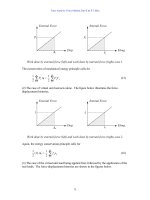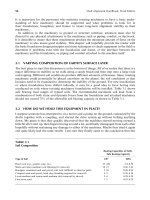ARNOLD, K. (1999). Design of Gas-Handling Systems and Facilities (2nd ed.) Episode 1 Part 5 pps
Bạn đang xem bản rút gọn của tài liệu. Xem và tải ngay bản đầy đủ của tài liệu tại đây (1.66 MB, 25 trang )
86
Design
of
GAS-HANDLING
Systems
and
Facilities
[text
continued from page
83)
Generally,
the
following design criteria should
be
provided
to
the
man-
ufacturers
or
vendors
for
sizing
an
exhaust heat recovery
unit.
1.
Total heat duty required
to
heat
the fluid
2.
Properties
of the fluid to be
heated
3.
The
outlet temperature
of the
heated
fluid
4.
Operational relationships between heat sources
and
users
(e.g.,
which
users continue
to
operate when sources shut down?)
5.
Exhaust
gas flow
rates
at
anticipated ambient
and at
various loads
from
maximum
to
minimum
6.
Exhaust
gas
temperature
at
anticipated ambient
and at
various loads
7.
Maximum exhaust
back
pressure
8.
Ambient temperature range
The
design
of
heaters
and
waste heat
recovery
units
is
beyond
the
scope
of
this book. Sizing
and
design
are
best
left
to
manufacturers,
However,
the
concepts discussed
in
this chapter
and in
Chapter
2 can be
used
to
verify
the
manufacturer's proposals.
HEAT
EXCHANGER
EXAMPLE
PROBLEM
Design
a
seawater cooler
to
cool
the
total
stream
from
the
example
field
in its
later
stages
of
life from
a flowing
temperature
of
175°F
to a
temperature
of
100°F
to
allow
further
treating.
Given:
Inlet
100
MMscfd
at
0.67
SG
(from
Table 2-10)
6,000
bopd
at
0.77
SG
15
bbl
water/MMscf
T,
=
175°F
P,
=
1,000
psig
Water
vapor
in gas
=
60
Ib/MMscf
(See Chapter
4.)
Outlet
T
2
=100°F
P2
=
990
psig
Water
vapor
in gas = 28
Ib/MMscf
(See Chapter
4.)
Seawater
T
3
=
75°F
Limit
temperature
rise to
10°F
Use
1-in.
OD
10
BWG
Tubes
on
iM-in.
Pitch
Heat
Exchangers
87
PlpJMejQi
1.
Calculate water
flow
rate
in
outlet
and
water vapor condensed.
2.
Calculate heat duty.
3.
Determine seawater circulation rate.
4.
Pick
a
type
of
exchanger
and
number
of
tubes required.
Solution:
1.
Calculate
free
water
and
water vapor
flow
rates.
Water
flow
rate
in
inlet:
Free
water
=
(100 MMscfd)(15
bbl/MMscfd)
=
1,500 bwpd
Water
flow
rate
in
outlet:
Free water
=
1,500 bwpd
Water
vapor condensed:
Water
flow
rate
in
outlet:
2.
Calculate heat
duty
a. Gas
duty
T,
=
635°R
T
2
=
560°R
T
av
=597.5°R
P
c
= 680
psia (Table
2-10)
P
R
=
P/P
C
=1.47
T
r
=
375°R
(Table 2-10)
T
R
=
T
av
/T
c
=
1.59
q
g
=
41.7(AT)C
g
Q
g
C
g
=
2.64
[29 x S x C
-f
AC
p
j
C
-
0.528
Btu/lb°F (Figure
2-14)
b.
Condensate
duty
c.
Free
water duty
d.
Water latent heat duty
e.
Total heat
duty
3.
Water circulation rate
Limit
AT for
water
to
10°F
to
limit
scale.
4.
Heat exchanger type
and
number
of
tubes
Choose
TEMA
R
because
of
large size.
Select type
AFL
because
of low
temperature change
and
LMTD
correction factor.
Heat Exchangers
89
The
water
is
corrosive
and may
deposit
solids. Therefore,
flow
water
through tubes
and
make
the
tubes
70/30
Cu/Ni. Flow
the
gas
through
the
shell.
Calculate
LMTD:
Correction
factor
(Figure
3-10):
Calculate
number
of
tubes:
90
Design
of
GAS-HANDLING
Systems
and
Facilities
From
Table
3-4 for
1-in.
OD,
IM-in,
square pitch,
fixed
tube
sheet,
four
passes,
shell
ID = 29 in.
Use
39-in.
ID x 20 ft Lg
w/682 1-in.
OD, 10 BWG
tubes
VA-'m.,
square
pitch
with
four
tube passes:
Check
the
water velocity
in
tubes.
From
Volume
1:
u
There
are
four
passes.
Thus,
682/4
tubes
are
used
in
each
pass,
Comments About Example
Once
a
specific heat exchanger
is
chosen,
the flow per
tube
is
known,
so it is
possible
to use the
correlations
of
Chapter
2 to
calculate
a
more
precise overall heat transfer coefficient (U).
An
example
of
calculation
of
U
is
given
in
Chapter
5.
Note
that more than
30% of the
heat
duty
was
required
to
cool
the
water
and
condensate.
If the
liquids
had first
been separated,
a
smaller exchanger
and
lower seawater
flow
rate could have been used.
In
most
gas
facilities,
where
cooling
is
required,
the
cooler
is
placed downstream
of the first
sep-
arator
for
this reason.
Often
an
aerial
cooler
is
used
for
this service.
Heat
Exchangers
91
In
this example
we
selected
a
final
outlet temperature
of
100°F. This
would
be
sufficiently
low if the gas
were only going
to be
compressed
and
dehydrated.
For our
case,
we
must also treat
the gas for
H
2
S
and
CO
2
removal
(Chapter
7). If we
chose
an
amine
unit, which
we
will
in all
like-
lihood,
the
heat
of the
reaction
could heat
the gas
more than
10°
to
20°F,
making
the
next step, glycol dehydration,
difficult
(Chapter
8). In
such
a
case,
it
may be
better
to
cool
the gas
initially
to a
lower temperature
so
that
it is
still
below
110°F
at the
glycol dehydrator. Often this
is not
pos-
sible, since cooling water
is not
available
and
ambient
air
conditions
are
in
the
95
°F to
100°F
range.
If
this
is so, it may be
necessary
to use an
aerial
cooler
to
cool
the gas
before
treating,
and
another
one to
cool
it
before
dehydration.
CHAPTER
4
Hydrates
*
Resembling
dirty ice, hydrates consist
of a
water lattice
in
which
light
hydrocarbon
molecules
are
embedded. They
are a
loosely-linked crys-
talline chemical compound
of
hydrocarbon
and
water called
cathrates,
a
term
denoting compounds that
may
exist
in
stable
form
but do not
result
from
true chemical combination
of all the
molecules
involved. Hydrates
normally
form
when
a gas
stream
is
cooled below
its
hydrate
formation
temperature.
At
high pressure these solids
may
form
at
temperatures
well
above 32°F. Hydrate formation
is
almost always undesirable because
the
crystals
may
cause plugging
of flow
lines, chokes, valves,
and
instrumen-
tation;
reduce
line capacities;
or
cause physical damage. This
is
especially
true
in
chokes
and
control valves where there
are
large pressure drops
and
small
orifices.
The
pressure drops cause
the
temperature
to
decrease,
and
the
small orifices
are
susceptible
to
plugging
if
hydrates form. Hydrate
formation
leading
to
flow
restrictions
is
referred
to as
"freezing."
The two
major
conditions that promote hydrate formation
are (1) the gas
being
at the
appropriate temperature
and
pressure,
and (2) the gas
being
at
or
below
its
water
dew
point
with
"free water" present.
For any
particular
composition
of gas at a
given pressure there
is a
temperature below which
hydrates
will
form
and
above which hydrates
will
not
form.
As the
pressure
increases,
the
hydrate
formation
temperature also increases.
If
there
is no
*Reviewed
for the
1999
edition
by
Dennis
A.
Crupper
of
Paragon Engineering
Services,
Inc.
92
Hydrates
93
free
water, that
is,
liquid water, hydrates cannot
form.
Secondary condi-
tions such
as
high
gas
velocities,
agitation
of any
type,
and the formation
of
a
nucleation
site
may
also help
form
hydrates. These secondary
condi-
tions
are
almost always present
in the
process piping stream.
Methods
of
preventing hydrate formation include adding heat
to
assure
that
the
temperature
is
always above
the
hydrate formation temperature,
lowering
the
hydrate formation temperature with
chemical
inhibition,
or
dehydrating
the gas so
that water vapor will
not
condense into free water.
It
is
also feasible
to
design
the
process
so
that
if
hydrates
form
they
can
be
melted before they plug equipment.
Before
choosing
a
method
of
hydrate prevention
or
dehydration,
the
operating system should
be
optimized
so as to
minimize
the
necessary
treating. Some general factors
to
consider include
the
following:
(1)
reduce
pressure
drops
by
minimizing line lengths
and
restrictions,
(2)
take
required pressure drops
at the
warmest conditions possible,
and (3)
check
the
economics
of
insulating pipe
in
cold areas.
This chapter discusses
the
procedures used
to
calculate
the
temperature
at
which
hydrates
will
form for a
given pressure
(or the
pressure
at
which
hydrates will
form
for a
given temperature),
the
amount
of
dehydration
required
to
assure that water vapor
does
not
condense
from a
natural
gas
stream,
and the
amount
of
chemical inhibitor that must
be
added
to
lower
the
hydrate formation temperature.
It
also discusses
the
temperature
drop
that occurs
as gas is
expanded
across
a
choke. This latter calculation
is
vital
to the
calculation
of
whether hydrates
will
form
in a
given stream.
The
next chapter discusses
the use of LTX
units
to
melt
the
hydrates
as
they
form,
and the use of
indirect
fired
heaters
to
keep
the gas
temperature
above
the
hydrate
formation
temperature. Chapter
8
describes processes
and
equipment
to
dehydrate
the gas and
keep
free
water
from
forming.
DETERMINATION
OF
HYDRATE
FORMATION
TEMPERATURE
OR
PRESSURE
Knowledge
of the
temperature
and
pressure
of a gas
stream
at the
well-
head
is
important
for
determining whether hydrate formation
can be
expected
when
the gas is
expanded into
the
flow
lines.
The
temperature
at
the
wellhead
can
change
as the
reservoir
conditions
or
production rate
changes over
the
producing life
of the
well. Thus, wells that initially
flowed
at
conditions
at
which hydrate formation
in
downstream equipment
was
not
expected
may
eventually require hydrate prevention,
or
vice versa.
94
Design
of
GAS-HANDLING
Systems
and
Facilities
If
the
composition
of the
stream
is
known,
the
hydrate temperature
can
be
predicted using vapor-solid (hydrate) equilibrium constants.
The
basic
equation
for
this prediction
is:
where
Y
n
=
mol
fraction
of
hydrocarbon component
n in gas on a
water-free
basis
K
n
=
vapor-solid equilibrium constant
for
hydrocarbon
component
n
The
vapor-solid equilibrium constant
is
determined experimentally
and
is
defined
as the
ratio
of the mol
fraction
of the
hydrocarbon component
in
gas on a
water-free
basis
to the mol
fraction
of the
hydrocarbon
com-
ponent
in the
solid
on a
water-free basis. That
is:
where
x
n
=
mol
fraction
of
hydrocarbon
component
in the
solid
on
a
water-free
basis
Graphs giving
the
vapor-solid equilibrium constants
at
various temper-
atures
and
pressures
are
given
in
Figures
4-1
through
4-4.
For
nitrogen
and
components heavier than butane,
the
equilibrium constant
is
taken
as
infinity.
The
steps
for
determining
the
hydrate temperature
at a
given system
pressure
are as
follows:
1.
Assume
a
hydrate formation temperature.
2.
Determine
K
n
for
each component.
y
3.
Calculate
-~
for
each
component.
K
n
y
n
4. Sum the
values
of
——.
K
n
5.
Repeat steps
1-4
for
additional assumed temperatures until
the
sum-
y
mation
of
—
—
is
equal
to
1.0
K
n
Hydrates
95
Figure
4-1.
Vapor-solid
equilibrium
constant
for (a)
methane,
(b)
ethane,
and
n-
butane.
(From
Gas
Processors
Suppliers
Association,
Engineering
Data
Book.}
96
Design
of
GAS-HANDLING
Systems
and
Facilities
Figure
4-2,
Vapor-solid
equilibrium
constant
for
propane,
(from
Gas
Processors
Suppliers
Association,
Engineering
Data
Book,
10th
Edition.)
Hydrates
97
Figure
4-3.
Vapor-solid
equilibrium
constants
for
isobutane.
(From
Gas
Processors
Suppliers
Association,
Engineering
Data
Book,
10th
Edition.)
The
presence
of
H
2
S
should
not be
overlooked
in the
determination
of
susceptibility
of a gas to
form hydrates.
At
concentrations
of 30% or
greater,
hydrates will
form
in
hydrocarbon gases
at
about
the
same
tem-
perature
as in
pure
H
2
S.
Table
4-1
is an
example calculation
of the
temperature below which
hydrates will
form
at the
4,000
psia flowing temperature
for the
example
gas
composition
of
Table
1-1.
From this calculation, hydrates will
form
at
temperatures below 74°F.
If
the gas
composition
is not
known, this procedure cannot
be
used
to
develop
the
hydrate formation point.
Figure
4-5
gives approximate
hydrate
formation
temperatures
as a
function
of gas
gravity
and
pressure.
For
example,
for the
0.67
specific gravity
gas of our
example field (Table
2-10),
Figure
4-5
predicts
a
hydrate formation temperature
at
4,000
psia
at
76°F.
98
Design
of
GAS-HAN
DUNG
Systems
and
Facilities
Figure
4*4.
Vapor-solid
equilibrium
constants
(a)
for
carbon
dioxide,
(b) for
hydrogen
sulfide.
(From
Gas
Processors
Suppliers
Association,
Engineering
Data
Book
10th
Edition.)
CONDENSATION
OF
WATER
VAPOR
One
method
of
assuring that hydrates
do not
form
is to
assure that
the
amount
of
water vapor
in the gas is
always less than
the
amount required
to
fully
saturate
the
gas.
Typically,
but
not
always,
the gas
will
be
saturat-
ed
with water
in
the
reservoir.
As the gas is
cooled
from
reservoir
tem-
perature,
the
amount
of
water vapor contained
in the gas
will decrease.
That
is,
water will condense.
The
temperature
at
which water condenses
from
natural
gas is
called
its
dew
point.
If the gas is
saturated
with
water vapor,
it is by
definition
at
its dew
point.
The
amount
of
water vapor saturated
in the gas is
given
Hydrates
99
Table
4-1
Calculation
of
Temperature
for
Hydrate
Formation
at
4,000
psia
Component
Nitrogen
Carbon dioxide
Hydrogen
sulfide
Methane
Ethane
Propane
Isobutane
n-Butane
Pentane"
1
"
Total
Interpolating linearly,
y
n
,
Mole
Fraction
in
Gas
0.0144
0.0403
0.000019
0.8555
0.0574
0.0179
0.0041
0.0041
0.0063
1.0000
Y/K=1.0at74
0
]
At
70
Kn
Infinity
Infinity
0.3
0.95
0.72
0.25
0.15
0.72
Infinity
F
°F
y
n
/i<
n
0.00
0.00
0.00
0.90
0.08
0.07
0.03
0.00
0.00
J.08
At
80°
K
n
Infinity
Infinity
0.5
1.
05
1.22
Infinity
0.6
1.22
Infinity
F
Yn/Sn
0.00
0.00
0.00
0.81
0.05
0.00
0.01
0.00
0.00
0.87
Figure
4-5.
Approximate hydrate temperature formation.
(Courtesy
of
Smith
Industries,
Inc.)
100
Design
of
GAS-HANDLINCr
Systems
and
facilities
by
Figure
4-6.
The
graph shows
the
water content
in
pounds
of
water
per
MMscf
of
saturated
gas at any
pressure
and
temperature.
For
example,
at
150°F
and
3,000
psi,
saturated
gas
will
contain approximately
105
Ib of
water
vapor
per
MMscf
of
gas.
If
there
is
less water vapor,
the gas is not
saturated
and its
temperature
can be
reduced without water condensing.
If
the gas is
saturated
at a
higher temperature
and
then cooled
to
L50°R
water
will
condense until there
are
only
105
Ib
of
water vapor
left
in the
gas.
The
dotted line crossing
the
family
of
curves shows
the
approximate
temperature
at
which hydrates
will
probably form
at any
given
pressure.
Note
the
hydrates form more easily
at
higher pressures.
To
keep water
from
condensing
as the gas is
processed,
it is
necessary
to
dehydrate
the gas
(that
is,
remove water vapor)
until
the
amount
of
water
vapor remaining
in the gas is
less
than
that required
to
fully
satu-
rate
the gas at all
conditions
of
temperature
and
pressure. Since
the
dehy-
drated
gas
will have
a
lower
dew
point, dehydration
is
sometimes called
dew
point
depression.
For
example,
if the
amount
of
water vapor
in the
3,000
psig
gas
stream referred
to
earlier were reduced
from
105
Ib/MMscf
to 50
Ib/MMscf,
the dew
point would
be
reduced
from
150°F
to
127°F.
That
is, its dew
point will
be
depressed
by
23°F.
Figure
4-6
contains
an
approximate hydrate formation line. This
should
be
used with care,
as the
position
of the
line depends
on the gas
composition.
It is
better
to
calculate
the
hydrate formation temperature
or
use
Figure
4-5 for
approximation.
TEMPERATURE
DROP
DUE TO GAS
EXPANSION
Choking,
or
expansion
of gas
from
a
high pressure
to a
lower pressure,
is
generally
required
for
control
of gas flow
rates.
Choking
is
achieved
by
the use of a
choke
or a
control valve.
The
pressure
drop
causes
a
decrease
in the gas
temperature, thus hydrates
can
form
at the
choke
or
control
valve.
The
best
way to
calculate
the
temperature drop
is to use a
simulation
computer
program.
The
program will perform
a flash
calcula-
tion,
internally balancing enthalpy.
It
will
calculate
the
temperature
downstream
of the
choke, which assures that
the
enthalpy
of the
mixture
of
gas and
liquid upstream
of the
choke equals
the
enthalpy
of the new
mixture
of
more
gas and
less
liquid downstream
of the
choke.
For
a
single component
fluid,
such
as
methane,
a
Mollier
diagram.
such
as
Figure
4-7,
can be
used
to
calculate temperature drop
directly.
Hydrates
101
Figure
4-6.
Dew
point
of
natural
gas.
{From
Gas
Processors
Suppliers
Association,
Engineering
Data
Book,
10th
Edition.}
4-7,
Typical
Gas
Association,
ICHh
Hydrates
103
Natural
gas is not a
single component
and a
Mollier diagram
will
proba-
bly
not be
available.
Figure
4-8 can be
used
to get a
quick approximate solution
for the
temperature
drop
of a
natural
gas
stream.
For
example,
if the
initial pres-
sure
is
4,000
psi and the
final
pressure
is
1,000
psi,
AP is
3,000
psi and
the
change
in
temperature
is
80°F.
This curve
is
based
on a
liquid con-
centration
of 20
bbl/MMscf.
The
greater
the
amount
of
liquid
in the gas
the
lower
the
temperature drop, that
is, the
higher
the
calculated
final
temperature.
For
each increment
of 10
bbl/MMscf
there
is a
correction
of
5°F.
For
example,
if
there
is no
liquid,
the
final
temperature
is
10°F
cool-
er
(the temperature drop
is
10°F more) than indicated
by
Figure 4-8.
Another
technique
that
can be
used
to
account
for the
presence
of
liq-
uids
is to
assume that
the
water
and oil in the
stream pass through
the
choke with
no
phase
change
or
loss
of
temperature.
The gas is
assumed
to
cool
to a
temperature given
in
Figure 4-8.
The
heat capacity
of the
liquids
is
then
used
to
heat
the gas to
determine
a new
equilibrium temperature.
THERMODYNAMIC
INHIBITORS
1.
Chemicals
can be
injected into
the
production stream
to
depress
the
likelihood
of
significant hydrate formation.
2.
A
therrnodynamic
inhibitor alters
the
chemical potential
of the
hydrate
phase
such that
the
hydrate formation point
is
displaced
to a
lower
temperature
and/or
a
higher pressure.
3.
Generally,
an
alcohol
or one of the
glycols—usually
methanol,
eth-
yiene
glycol
(EG),
or
diethylene
glycol
(DEG)—is
injected
as an
inhibitor.
All may be
recovered
and
recirculated,
but the
economics
of
methanol recovery will
not be
favorable
in
most cases.
The
most common inhibitor
in
field
gas
situations, where
the
inhibitor
will
not be
recovered
and
reused,
is
methanol.
It is a
relatively inexpen-
sive
inhibitor. Methanol
is
soluble
in
liquid hydrocarbons, about 0.5%
by
weight.
If
there
is
condensate
in the
stream, additional methanol
is
required because some
of
that methanol will dissolve
in the
condensate,
Also, some
of the
methanol vaporizes
and
goes
into
the gas
state.
Ethylene
glycol
is the
most common recoverable inhibitor.
It is
less
soluble
in
hydrocarbons
and has
less
vaporization
loss
than methanol.
This
is
common
on the
inlet
to gas
processing
plants.
4-8,
for gas
Gas
Oato
Boole,
9lh
Edition.}
Hydrates
105
The
Hammerschmidt
equation
may be
used
in
calculating
the
amount
of
inhibitor required
in the
water phase
to
lower
the
hydrate temperature:
Table
4-2
Inhibitors
and
Constants
Inhibitor
Methanol
Ethanol
Isopropanol
Ethylene
glycol
Propylene
glycol
Diethylene
glycol
MW
32.04
46,07
60.10
62.07
76.10
106.10
K
2,335
2,335
2,335
2,200
3,590
4,370
where
AT =
depression
of
hydrate formation temperature,
°F
MW
=
molecular weight
of
inhibitor (Table 4-2)
K
=
constant (Table 4-2)
W
=
weight percent
of
inhibitor
in
final
water phase
The
amount
of
inhibitor required
to
treat
the
free
water,
as
given
by
Equation 4-3, plus
the
amount
of
inhibitor lost
to the
vapor
phase
and the
amount
that
is
soluble
in the
hydrocarbon liquid will
be the
total amount
required. Figure
4-9 is a
chart
for
determining
the
amount
of
methanol
that
will
be
lost
to the
vapor phase. Approximately 0.5% will
be
soluble
in
the
hydrocarbon liquid.
The
procedure
for
calculating methanol usage
can
best
be
explained
by
an
example.
Given
a
flowing temperature
for one
well
of our
example
field
of
65
°F (as
could occur with
a
remote well
and
subsea
flow
line),
calculate
the
methanol required
to
prevent hydrates from forming.
Assume that
at the
high flowing pressure
there
is no
free
water,
but the
gas is
saturated.
First
the
amount
of
water that will
be
condensed will
be
determined
from
Figure
4-6, assuming
the gas is
saturated
at
reservoir
conditions.
106
Design
of
GAS-HANDLING
Systems
and
Facilities
Water
content
(8,000
psig
and
224°F)=
230
Ib/MMscf
Water
content
(4,000
psig
and
65°F)
=
JK)
Ib/MMscf
Water
condensed
= 220
Ib/MMscf
From.
Table
4-1 the
hydrate temperature
is
74°F.
The
required dew-
point
depression then will
be
74-65
=
9°F.
The
concentration
of
methanol
required
in the
liquid phase
from
Equa-
tion 4-3 is:
Desired
methanol
in
liquid phase
=
0.11
x 220
Ib/MMscf
=
24.2
lb/
MMscf
Figure 4-9. Ratio
of
methanol
vapor
to
liquid
composition
vs.
pressure
at
various
temperatures.
Hydrates
107
From
Figure
4-9 the
methanol
that
will
flash
to
the
vapor
at
4,000
psig
and
65°F
is:
Methanol
in
vapor state
=
1.0
x
11.0
=
11.0
Ib/MMscf
Since
a
barrel
of
hydrocarbon weighs about
300
Ib,
the
amount
of
methanol soluble
in the
hydrocarbon liquid phase
will
be:
0.005
x 300
Ib/bbl
x 60
bbl/MMscf
=
90.0
Ib/MMscf
Thus,
the
total amount
of
methanol required:
Water
liquid phase
—
24.21b/MMscf
Vapor
phase
—
11.0
Ib/MMscf
Hydrocarbon liquid phase
—
90.0
Ib/MMscf
125.2
Ib/MMscf
Note that
the
amount
of
methanol soluble
in the
condensate
is
crucial
to
determining
the
amount
needed.
Approximately
125
Ib
of
methanol must
be
added
so
that approximately
25
Ib
will
be
dissolved
in the
water phase.
Since
the
specific gravity
of
methanol
is
0,8,
this
is
equivalent
to:
For
this case
it is
impractical
to
lower
the dew
point with methanol.
A
more
practical
solution would
be to
separate
the
condensate first.
At
1,000
psia
the dew
point
is
68.4°F
(see
example
in
Chapter
5).
Assuming
a
separator
temperature
of
75°F
the
amount
of
methanol
needed
to
lower
the
dew
point
of gas to
65°F
is 9.7
Ib/MMscf.
Using
a
surge factor
of
1.4,
the
required
injection rate
is
only
13.6
Ib/MMscf
or 2.0
gal/MMscf.
KINETIC
INHIBITORS
AND
ANTI-AGGLOMERATORS
A
kinetic inhibitor
is a
polymeric chemical that,
when
added
to a
pro-
duction stream, will
not
change
the
hydrate formation temperature
but
will
delay
the
growth
of
hydrate crystals. These chemicals
are
polymeric
108
Design
of
GAS-HANDLING
Systems
and
Facilities
and
include
N-vinylpyrrolidone
(5
ring),
saccharides
(6
ring},
and
N-
vinylcaprolactam
(7
ring).
An
anti-agglomerator
is an
alkyl
aromatic
sulphonate,
a
quaternary
ammonium
salt,
or an
alkyl glycoside surfactant. When added
to a
pro
duction
stream with
a
continuous
oil
phase, this chemical will
minimise
hydrate
crystals from agglomerating
or
growing
in
size.
The
continuous
oil
phase provides
a
medium
to
transport
the
hydrate crystals through
the
piping
system while crystal growth
is
delayed.
This
chemical
and
its
physical
reaction
with
hydrate crystals
is not
dependent upon
the
amount
of
subcooling
and
therefore
has a
wide range
of
pressure-temperature
applications.
The use of
kinetic inhibitors
and/or
anti-agglomerators
in
actual
field
operations
is a new and
evolving technology. These
are
various formula-
tions
of
chemicals that
can be
used
in a
mixture
of one or
more
kinetic-
inhibitors
and/or
anti-agglomerators.
At the
current time,
to get an
"opti-
mum" mixture
for a
specific application
it is
necessary
to set up a
con-
trolled bench test using
the
actual
fluids
to be
inhibited
and
determine
the
resulting
equilibrium phase line.
As the
mixture
of
chemicals
is
changed,
a
family
of
equilibrium phase lines
will
develop. This will result
in an
initial
determination
of a
near
"optimum"
mixture
of
chemicals.
To
determine
the
appropriate injection rate,
a
field test should
first
be
performed
at one of the
industry-sponsored full-scale loop test facilities.
The
"optimum"
mixture,
its
injection rate,
and
location
of
injection
points
will
be a
function
of
flow geometry,
fluid
properties, pressure-
temperature relationships,
etc.,
that will
be
encountered
in the
actual
field
application.
The
appropriate injection rate
and
location
of
injection
points
can be
determined
from
this test
by
observing pressure increases,
which
indicate that hydrate plugs
are
forming.
Application
of
this "optimum mixture
of
chemicals"
in the
actual
field
installation would begin with
the
design injection
rate
of the
mixture
and
by
adding
a
sufficient concentration
of a
thermodynamic inhibitor
to
inhibit
the
free
water that
may
exist
in low
spots
in the
piping system.
After
the
system
has
reached
an
operating
equilibrium,
the
volume
of the
thermodynamic
inhibitor
is
then
decreased
in
stages with
a
time period
between
each stage
to
ensure that
no
hydrate plug
is
formed. Some
small
amount
of
thermodynamic inhibitor
will
continue
to be
used
to
inhibit
free
water
in low
spots.
In
this manner
the
lowest
chemical
cost that
will
provide
the
necessary flow assurance
is
eventually reached.
CHAPTER
5
LTX
Units
and
Line
Heaters
*
Chapter
4
discussed
the
need
to
prevent hydrates,
the
techniques
nec-
essary
to
predict hydrate formation,
and the use of
chemical
inhibitors.
This chapter covers
two
types
of
equipment
for
handling hydrates.
Low-temperature exchange (LTX) units
use the
high
flowing
tempera-
ture
of the
well stream
to
melt
the
hydrates
after
they
are
formed. Since
they
operate
at low
temperatures, they also stabilize
the
condensate
and
recover more
of the
intermediate hydrocarbon components than would
be
recovered
in a
straight multistage
flash
separation process.
Indirect
fired
heaters
(sometimes
called
line
heaters)
heat
the gas
stream before
and/or
after
the
choke
so
that
the gas is
maintained above
the
hydrate temperature. Indirect fired heaters
can
also
be
used
to
heat
crude
oil for
treating, heat
a hot fluid
circulating medium (heat medium)
that
is
used
to
provide process heat,
etc.
There
are
many other types
of
heat exchanger
devices
that
can be
used
to
heat
the gas
above
the
hydrate temperature.
These
could include shell
and
tube heat exchangers, electrical immersion heaters, furnaces,
etc.
However,
the
most common equipment type used
to
heat
a
well stream
Is
the
indirect
fired
water bath heater.
*
Reviewed
for the
1999
edition
by
Kevin
R.
Mara
of
Paragon Engineering Services,
Inc.
109
110
Design
of
GAS-HANDLING
Systems
and
Facilities
LTX
UNITS
These units
are
designed
to
allow hydrates
to
form
and to
melt
them
with
the
heat
of the
incoming
gas
stream before they
can
plug down-
stream
equipment.
In
addition,
the
low-temperature separation
that
occurs
in an LTX
unit results
in
stabilizing
the
liquids
as
discussed
in
Chapter
6.
This results
in an
increase
in
liquids recovered
and a
corre-
sponding
decrease
in the
heating value
of the gas
over what would
be the
case
with
separation
at
normal
temperatures.
Figure
5-1
shows
a
typical
LTX
process.
The
inlet
gas
stream
is
choked
at the
well
to
2,000
to
3,000
psi or
until
the
temperature declines
to
approximately
120°F,
which
is
well above
the
hydrate
formation
tem-
perature.
The
inlet stream next enters
a
coil
in the
bottom
of the low
tem-
perature
separator.
The
stream
is
then
cooled
to
just above
the
hydrate
formation
temperature with
the
outlet
gas
coming
off the low
tempera-
ture
separator.
This assures
the
lowest possible temperature
for the
inlet
stream
when
it
enters
the
vessel
after
the
choke. This choke
is
mounted
in
the
vessel itself. When
the
pressure drop
is
taken,
the
temperature
will
Figure
5-1.
Typical low-temperature exchange unit
(LTX).



